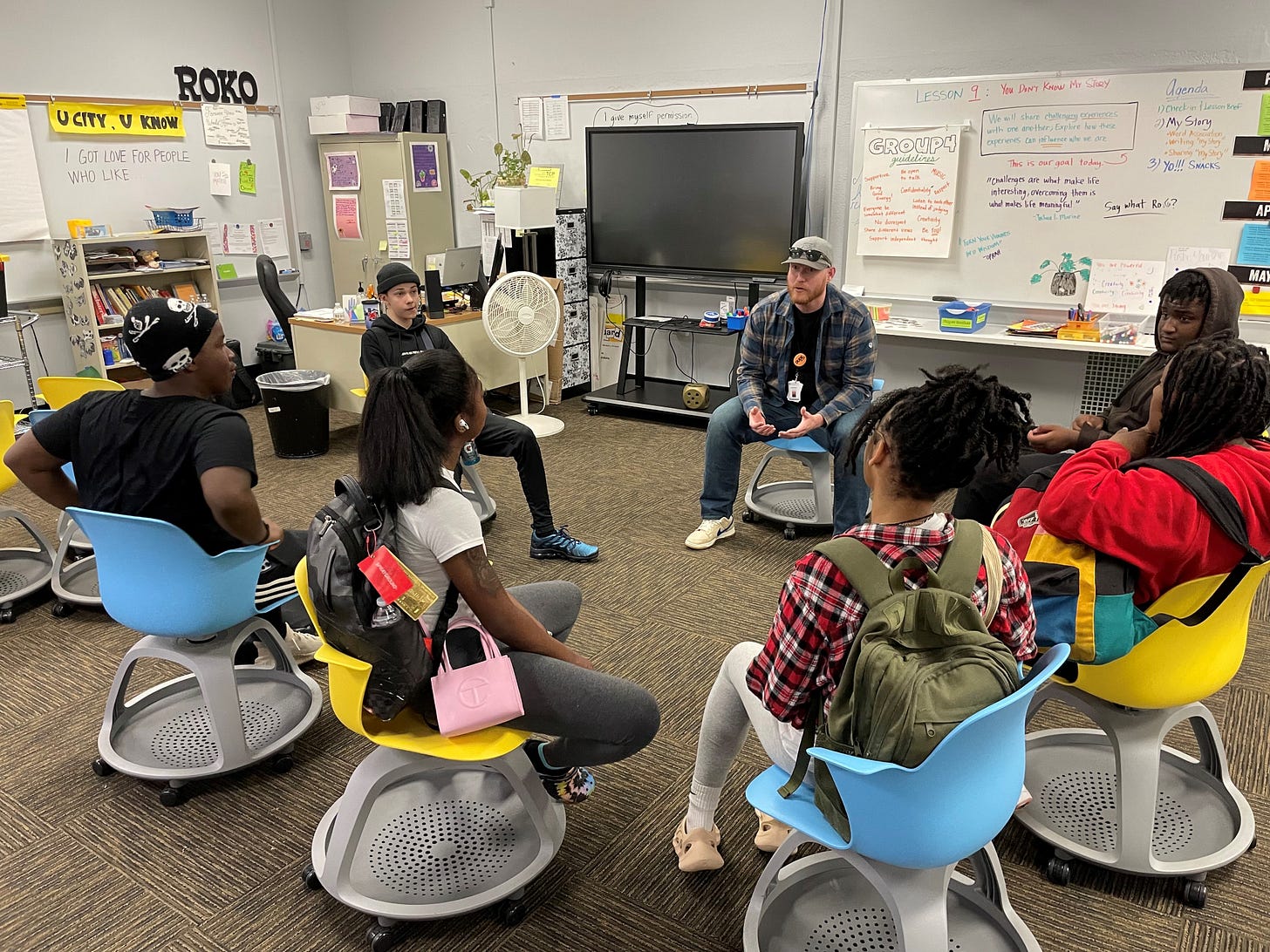ANEW: Making Essential Connections
A reflection on the grace of simple meetings and the rooms that hold us
In The Great Gatsby, there’s a brief scene where Jay Gatsby introduces Nick Carraway to one of his business contacts—the man who bragged about fixing the 1919 World Series. Leaving his harmful tropes and antisemitism aside, it’s Fitzgerald’s way of showing that not every connection carries the same weight. Some are built on advantage and illusion; others on care and truth.
Lately, I’ve been thinking more about the second kind—the connections that grow quietly and honestly, that root us somewhere deeper. Where they lead, I never quite know, but they feel essential. That’s when the sorting machine turns on—where are you from, where did you go to school, who do we know in common? In St. Louis, “Where’d you go to high school?” is both icebreaker and label-maker. I can feel myself reaching for it, then choosing not to. I want something truer than categories. I want the part where people surprise me.
We had a Sukkot meal the other night—kids bustling in and out with helpful responsibilities, adults meeting for the first time or for the first time in a long time. Our host asked if anyone had been to the Basilica downtown. Heads nodded. Then the stories came: a first visit with a grandparent, a choir concert where the acoustics felt like a blanket, a quiet weekday noon under the mosaics. A simple place question, and suddenly we weren’t strangers. We were people with memory.
I think about this a lot in schools. Years ago, we gave students a giant campus map and three colors of dots: green for safe, red for not, and yellow for neutral. No essays, just dots. It turned into an honest portrait of the places where the temperature rose or fell for a kid. You could see it in an instant: the classroom where they exhaled; the hallway where their shoulders tightened. Connection is not a slogan. It is a room that feels different in your body.
The other day, I met Allison Williams on Zoom. My good friend, Julio Suarez, made the introduction, and before I could pretend otherwise, we realized we basically live around the corner from each other—me in Glendale, Allison in Webster Groves. She is now the CEO of the Wyman Center, but she started there as a camp counselor. That mattered to me. There’s a through-line to people who remember the names of the kids from their first summer and never stop building on that feeling.
Allison and I talked about teenagers — the most misunderstood group in America, in my opinion. She lit up about the Teen Connection Project they run with high schoolers. The whole thing is grounded in the unglamorous work of belonging: naming emotions, practicing the tiny moves that keep a conversation going, learning how to hold a room safely so other people can show up as themselves. It’s not about giving a motivational speech and calling it a day. It’s about repetition, practice, and time.
What I loved was how ordinary it sounded. A semester in a health block. A trained adult. Circles that become classrooms, classrooms that feel like circles. And then the part every teacher knows: the real changes show up later. A student tries one thing at lunch. A kid texts a friend to check in when they normally wouldn’t. Somebody raises a hand who never raises a hand. The bloom after the bell.
Wyman wants to take that work to 100,000 teens over five years. Big number, yes. But I’m less interested in the number than the image of a student walking into a room that’s been prepared for them: an adult who knows how to hold the space, a set of routines you can count on, and a table where your voice won’t be punished for showing up. If you’ve been in schools long enough, you’ve watched a kid grow two inches just because an adult stayed.
I told Allison that in independent schools, we sell the myth that it’s all about test scores. The truth is, families are buying a web of adults who know their kid’s laugh, their tales/tells, and the moment to ask the follow-up question. When those adults stay—really stay—students carry those bonds like talismans. Outcomes matter, of course, but they’re downstream of relationship. If we don’t honor that, we build the house on sand.
We talked, too, about safety and containers. If you’ve worked in schools, you’ve seen the harm that happens when the container isn’t strong—when boundaries are fuzzy, training is cursory, or supervision is perfunctory. The best programs are humble about this: they tune the container before they tune the content. Adults learn how to model, name, and repair. Kids learn how to trust themselves inside a community that can hold a mistake without breaking the kid who made it.
What I appreciated most was Allison’s “why.” She started upstream, moved downstream, and then built a bridge between the two. You can hear it when she talks about teens: present tense, not future. Not “the children are our future,” but “the children are here right now.” That’s the shift. When you treat belonging as today’s work—not an investment vehicle for tomorrow’s metrics—you show kids they matter in the only time that really exists.
If I have a bias, it’s for people who give their time to other people’s children. Time is the most expensive thing we have. We can’t mint more. And yet the best folks keep spending it like water: showing up early, staying late, running the invisible errands of care. I keep finding these people. Or maybe they keep finding me. Either way, I’m grateful.
So no, this wasn’t a Gatsby connection. No smoky room, no backdoor deal. Just two neighbors with a shared center of gravity: make rooms where teenagers can breathe. I’ll share my writing with Allison; she’ll keep me posted on Wyman’s progress. Maybe we’ll bump into each other at a coffee shop. Maybe we’ll build something together down the line. For now, it’s enough to say we met, listened, and left the call a little more tethered than before.
Connections like that? I’ll take them every day.
May it always be so.
Curated Listening:
When I think about what sustains people like Allison—and anyone who gives their life to the good work and to the slow, quiet labor of connection—it’s this song. David Wilcox’s Show the Way has long been a kind of compass for me. Listen to it the way you’d listen to a friend’s voice on the phone after a long week — softly, without hurry. It’s a song that reminds us why the work of connection isn’t optional; it’s the whole reason we’re here. Listen to Show the Way HERE.
Supporting = Loving
(50% of the SUPPORT I receive is going to organizations I LOVE.)
Every week, I spend dozens and dozens of hours thinking about, writing, and keeping ANEW alive. I’d love for you to support not just these writing efforts but causes I care deeply about, like the Wyman Center, or the arts for communities at promise like COCA (Center of Creative Arts in St. Louis). Every so often, I will highlight what I am supporting in these pages. If you are so inclined, please consider supporting ANEW, which will enable me to help some deserving nonpartisan causes connected to kids. I will begin to highlight them occasionally, too. Your support makes all the difference in the world.




